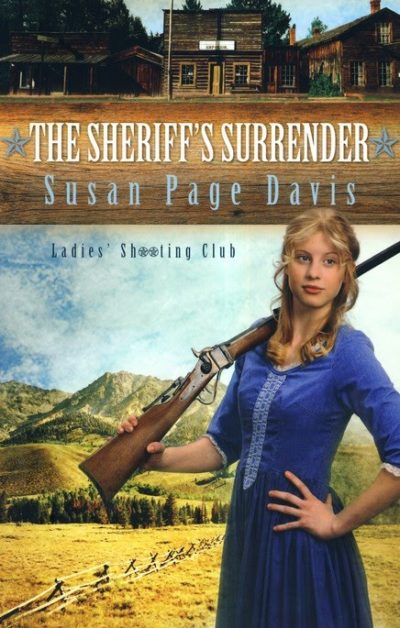Literary rating: ★★★★★
Kick-butt quotient: ☆☆
 Having started our acquaintance with the Ladies Shooting Club trilogy last year with the third book, The Blacksmith’s Bravery (long story), my wife Barb and I are now reading the other two volumes in order. Neither of us were disappointed in this one! My reviewing it here was a happy surprise. Although the covers of all three books feature gun-toting women, and a basic plot current of the trilogy is women learning to take responsibility for defending themselves and others, the heroine of the third book wasn’t actually called on to engage in any gun-fighting action. So I assumed the same would be the case here. But [at the risk of a mild “spoiler” –though for fans of this site, this will add interest rather than spoil it :-)], in this series opener, our heroine does need to step up to the plate with a Winchester. (Contrary to many fictional and movie depictions, rifles were used more for serious shooting in the Old West than six-guns). Despite that difference, though, both books have a lot of similarity in tone, content and style. Since I gave the concluding volume five stars on Goodreads, that’s a good thing!
Having started our acquaintance with the Ladies Shooting Club trilogy last year with the third book, The Blacksmith’s Bravery (long story), my wife Barb and I are now reading the other two volumes in order. Neither of us were disappointed in this one! My reviewing it here was a happy surprise. Although the covers of all three books feature gun-toting women, and a basic plot current of the trilogy is women learning to take responsibility for defending themselves and others, the heroine of the third book wasn’t actually called on to engage in any gun-fighting action. So I assumed the same would be the case here. But [at the risk of a mild “spoiler” –though for fans of this site, this will add interest rather than spoil it :-)], in this series opener, our heroine does need to step up to the plate with a Winchester. (Contrary to many fictional and movie depictions, rifles were used more for serious shooting in the Old West than six-guns). Despite that difference, though, both books have a lot of similarity in tone, content and style. Since I gave the concluding volume five stars on Goodreads, that’s a good thing!
In 1885 small-town Idaho, young Gert Dooley keeps house for her widowed brother, the town’s gunsmith. One thing she can do to help him is test fire the guns he repairs; and she’s gotten to be a crack shot over the years of doing this. When the town’s longtime sheriff is murdered in his office (the titular sheriff is his replacement), the usually quiet community is spooked; and a widowed storekeeper friend asks Gert to teach her how to use her late husband’s Colt, in case she needs it to protect herself or her business. There’s initially no thought of creating a club as such; but as other crimes follow and other women join in the lessons, the Ladies Shooting Club takes shape. Reactions among the community’s menfolk aren’t uniformly supportive –but not uniformly hostile either; stereotypical role expectations of female helplessness weren’t so ingrained in the late 19th-century West as they’d become later.
Despite the historical setting, the issue the novel poses is very contemporary, and hotly debated even today. Male chauvinists tend to see any use of weapons by females as transgressive of patriarchal norms. And while all feminists believe in “empowerment” for women in some sense, many of them either feel that pacifism is ideologically essential to true feminism, or believe that the State and its agents have an absolute monopoly on legitimate use of lethal force, which renders use of a gun for self-defense by ordinary citizens as nearly as bad as using it to attack an innocent. But another strand of feminism rejects that thinking, and views responsible and educated gun ownership as a legitimate tool of women’s empowerment. It’s not hard to deduce from this book what view of that matter Davis takes.
There’s nothing tract-like about this novel, however, any messages emerge naturally from the story itself. Christian faith plays a role in the lives of Gert and other characters, and of the town –the coming of a preacher and his wife to form a nondenominational community church is an important event, as it really was in many Western communities, where organized religion came more slowly than it did in the more easily-settled Eastern states– but the author isn’t “preachy” in her handling of this. The club is also a vehicle for creating female camaraderie and friendship that crosses social divides set by class, religion, and Victorian attitudes (it’ll eventually include both the preacher’s wife and a saloon owner and her girls), and some characters will have lessons to learn in that area.
But the main focus is on the question of what’s behind the sudden rash of arson and violence in the community. I’d describe this as a Western (and there’s horses, guns, a posse, and gun-play at the end), but it embodies very real characteristics of the mystery genre as well. (While I guessed the identity of the villain early on, I’m not sure many readers would –and you might have fun testing your own wits!) And in the background, we have regard and respect growing into love between a worthy man and woman.
Since this was the second book we read of the series, as Barb said, it was “like visiting old friends.” I’d recommend to new readers, though, that they read the books in order. And for us, it’s now on to our third book (which is actually the trilogy’s second), The Gunsmith’s Gallantry!
Author: Susan Page Davis
Publisher: Barbour Publishing, available through Amazon, both for Kindle and as a printed book.
A version of this review previously appeared on Goodreads.




